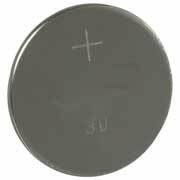
MONDAY, Sept. 20 (HealthDay News) — Small disc batteries can do severe damage to the esophagus of very young children who accidentally swallow them, a new pediatric case-study review suggests.
The analysis, which included 10 boys and girls as young as 10 months old, reinforces growing concern over the dangers posed by the increasing ubiquity of such disc (or “button”) batteries, generally smaller than a nickel, in a wide array of household products.
Stanley J. Kimball of Mount Carmel Health System in Columbus, Ohio, led a review of the treatments of 10 pediatric patients who accidentally swallowed a disc battery at some point between 1998 and 2008. His work was published in the September issue of the Archives of Otolaryngology — Head & Neck Surgery.
All 10 cases reviewed by Kimball involved endoscopic retrieval of such discs following X-rays and chest scans. The time that elapsed before treatment began ranged from six hours to 30 days. Half of the patients had either been observed swallowing the battery or were brought to the hospital following a cough. Two others spoke of their accident and complained of a sore throat. The remaining three patients were diagnosed by chance when in hospital, for other reasons.
When swallowed, the battery gets stuck in a child’s esophagus, and its interaction with bodily fluids prompts an electrical discharge that can cause tissue burning and severe damage.
Although three of the children experienced only minimal or superficial injury, five experienced severe damage to their esophageal lining, and two (those experiencing the longest delay to treatment) sustained a perforation to their esophagus. In one case, widespread injury resulted in the opening up of a hole between the patient’s trachea and esophagus.
The study team concluded that such disc battery accidents can have serious consequences for young patients, and physicians need to have a clear understanding of related symptoms and act as fast as possible to minimize the risk of long-term health complications.
Kimball and his associates noted that, according to the American Association of Poison Control Centers, more than 2,000 disc battery ingestions occurred among American children in 1998. But over the next eight years, there was an 80 percent jump in cases.
Nevertheless, Dr. Lee Sanders, an associate professor of pediatrics at the University of Miami Miller School of Medicine, said that concern over pediatric battery ingestions needs to be taken in context.
“I wouldn’t want to unnecessarily alarm the public, because the incidence of this occurrence is extraordinarily low,” he noted. “If you were to take all the other ingestible products and add them up all together, you’re only getting up to about 1 percent of the total child population in the United States that experiences this kind of an accident,” Sanders said.
“So, yes, absolutely this is a cause for concern,” he added. “The Consumer Product Safety Commission should be constantly surveying the situation. And parents need to be aware of it. But we don’t want to focus so much on this problem that we draw attention away from the need to protect children against those things that pose much greater dangers, such as car seats and safety, and the risk to children from falling, drowning and burns.”
Dr. Toby Litovitz, director of the National Capital Poison Center in Washington D.C., noted that while the incidence of battery ingestions has not actually risen in recent years, the health consequences of such ingestions are worse today than in the past.
“The frequency of the accident is not trending up,” she said. “But between 1985 and 2009, there has been a nearly sevenfold increase in the percent of button battery ingestions that have a severe or fatal outcome. And most of that increase has occurred in the last five years, and that is because of the increasing popularity of the 20mm lithium battery.”
However, Litovitz added, “I don’t see any point in convincing manufacturers not to use these batteries. They’re popular because they’re better.”
But, she explained, “because of their small size, these batteries tend to get stuck in a child’s esophagus, where their higher voltage compared with traditional batteries sets up a more rapid electrolysis reaction, which basically causes a severe chemical burn. So they need to be used intelligently so that children are protected.”
Noting that the vast majority of accidents occur when children remove batteries from product compartments (as opposed to being found loose around the house), Litovitz said that items such as garage door openers, calculators, watches, remote controls and talking books need to be designed with compartments that require tools to be opened.
“Not just toys, but any product should require a tool to open, so children cannot get into where the battery is stored,” she said.
More information
For more on poison prevention at home, visit the American Academy of Pediatrics.

